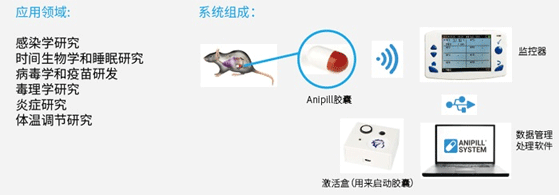Anipill®核心体温胶囊是一款可连续监测、记录并无线传输核心体温信号的微型胶囊。
适用动物及使用方式:小动物(大小鼠)可进行皮下或腹腔植入;中大型动物(比格犬、兔子、猪等)可选择皮下或腹腔植入,也可经口腔摄入进入体内,通过胃、肠道,最后由肛门排出。使用简单方便,广泛用于小动物以及中大型动物的核心体温监测。
ANIMALS MONITORING的动物核心体温胶囊包括:Anipill胶囊和Anilogger检测仪。
Anipill胶囊用于植入(或吞服入)动物体内,采集动物的核心体温;胶囊通过无线信号传输,将采集到的体温信息传输给Anilogger监测仪,进行显示和读取,是款无创式高精度的核心体温采集设备。


应用于体温调节研究、感染学、生物节律分析、动物休眠、免疫和疫苗开发、毒理学研究等加强对实验动物的体温监测。可以连续的收集可靠和准确的核心温度数据, 同时保持小动物的舒适性和可移动性等正常生理状态。

Anipill胶囊适用于多种动物,如:大鼠、小鼠、比格犬、兔子等。

体温胶囊的主要特点:
·胶囊体积小巧,可口服(视动物大小而定)或植入使用,使用简单,对动物友好;
·无线无导管测量,测试对象亦无需实时佩戴监测器,实现无任何限制测量方案;
·监测器可同时监测 8 枚胶囊数据,且自身可最多 7 台并联,实现测量高通量;
·胶囊内置存储记忆功能,可存储多达 2000 组数据,无需担心数据丢失;
·基于遥测技术,实时连续的核心温度监测。

主要技术参数:
测量参数:适用温度25-45℃,精确度0.02℃,采样频率30Hz(可设定),内部可存储2000组数据;
传输参数:传输距离1-3m,传输频率433Hz;
使用寿命:20天
规格参数:17.7*8.9mm,重1.7g;
可同时监测并显示8只动物体内胶囊的传输,并可通过PC/MAC观察分析;
每台监测器可存储150,185组数据;

应用1:体温调节研究

在四只食蟹猴的腹腔分别植入胶囊,然后把它们与其他未植入的食蟹猴在标准条件下共同饲养。在接下来的一周内,每隔15分钟测量一次体温,实验结果如图。本实验说明,Anipill系统可以用来连续、可靠地测量非人灵长类的体温,并且测量结果可以清晰地反映出食蟹猴体温的昼夜波动规律。
相关文献:
·Laperrousaz et al., (2018) Lipoprotein Lipase Expression in Hypothalamus is involved in the Central Regulation of Thermogenesis and the Response to Cold Exposure
·Meyer et al., (2017) Body Temperature Measurements for Metabolic Phenotyping in Mice
·Rufiange et al., (2020) Pre-warming before general anesthesia with isoflurane delays the onset of hypothermia in rats
应用2:动物生理学⸺时间生物学和睡眠研究
植入到非人灵长类腹膜的胶囊收集到的数据

在大鼠的腹腔内植入胶囊,7天后,监测以下三组大鼠的核心体温在麻醉前后的变化趋势:预热至40℃(PW40, n=17);预热至高于基线体温1%(PW1%, n = 17);无预热(NW, n = 17)。本实验说明,在麻醉之前给大鼠进行预热,有助于防止麻醉剂引起的体温过低。
相关论文:
1.van der Vinne V, Pothecary C A, Wilcox S L, et al. Continuous and non-invasive thermography of mouse skin accurately describes core body temperature patterns, but not absolute core temperature[J]. Scientific Reports, 2020, 10(1): 20680.
2.Delezie J, Gill J F, Santos G, et al. PGC-1β-expressing POMC neurons mediate the effect of leptin on thermoregulation in the mouse[J]. Scientific Reports, 2020, 10(1): 1-12.
3.van der Vinne V, Tachinardi P, Riede S J, et al. Maximising survival by shifting the daily timing of activity[J]. Ecology letters, 2019, 22(12): 2097-2102.
4.Hong S H, Hong J H, Lahey M T, et al. A low-cost mouse cage warming system provides improved intra-ischemic and post-ischemic body temperature control–application for reducing variability in experimental stroke studies[J]. Journal of neuroscience methods, 2021, 360: 109228.
5.Belloch F B, Beltrán E, Venzala E, et al. Primary role for melatonin MT2 receptors in the regulation of anhedonia and circadian temperature rhythm[J]. European Neuropsychopharmacology, 2021, 44: 51-65.
6.Tabarean I V. Neurotensin induces hypothermia by activating both neuronal neurotensin receptor 1 and astrocytic neurotensin receptor 2 in the median preoptic nucleus[J]. Neuropharmacology, 2020, 171: 108069.
7.Fenzl A, Kulterer O C, Spirk K, et al. Intact vitamin A transport is critical for cold-mediated adipose tissue browning and thermogenesis[J]. Molecular metabolism, 2020, 42: 101088.